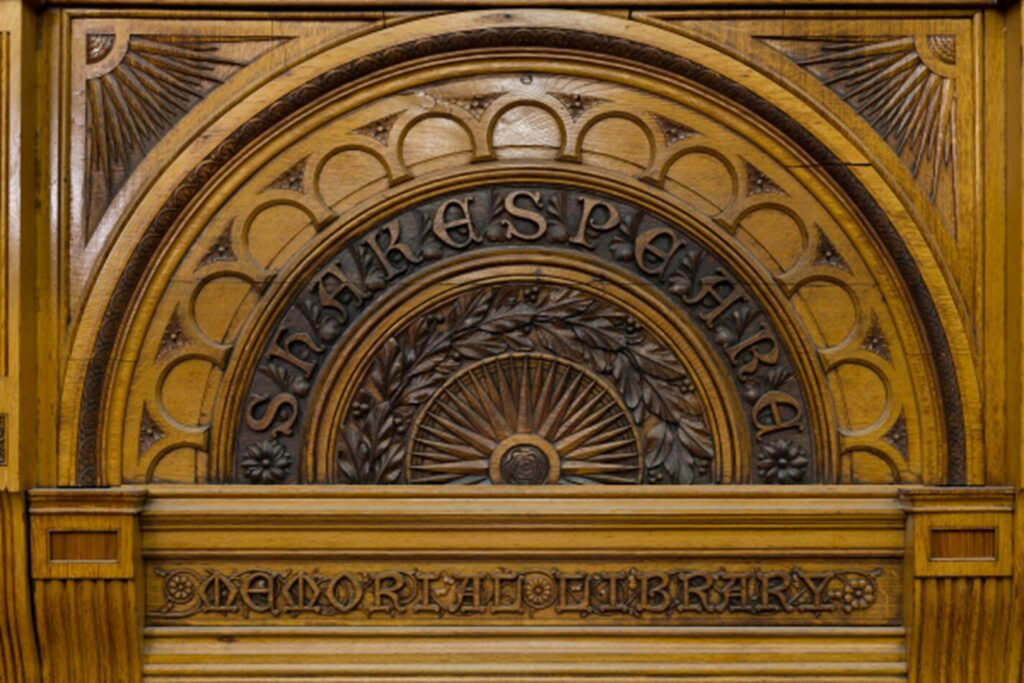A Roundhouse blog, written by Frankie, a member of the Visitor Centre team.
In this blog post in honour of Shakespeare’s birthday, we share the curious story of our building’s use in the 1970s. The Roundhouse acted as a storage depot for heritage treasures, including wooden panelling from Birmingham’s first Shakespeare library.
By 1978, the horses stabled at the Roundhouse had moved out, and visitors were few, but the building was still very much in use. In fact, the council were using the space as a conservation depot, maintaining a ‘reference library’ temperature to stop important objects from deteriorating. This included parts of Birmingham’s ‘Shakespeare Memorial Room’, a Victorian library space built in the 1880s to showcase the city’s Shakespeare collection.

So, what exactly was this room? Designed by the late-nineteenth-century architect John Henry Chamberlain, it featured wooden panelling with elaborate carvings of birds, flowers, and a ‘Shakespeare’ centrepiece, as well as stained glass windows and a plaster ceiling. You can see a reconstructed version of the room at the very top of the Library of Birmingham today (although the Shakespeare collection has now vastly outgrown this room and now boasts over 100,000 items!) J H Chamberlain designed many other key buildings as part of the civic gospel movement, such as the Birmingham School of Art, monument to Mayor Joseph Chamberlain (no relation!), and the Ikon Gallery. We explore many of these buildings on our city walking tours.

Shakespeare Memorial Room, Library of Birmingham.
In the 1970s, Birmingham was busy building its brutalist library, deciding that the old Shakespeare room did not quite fit the new style. The Birmingham Victorian Society held protests to save the room, and there were rumours that it might be sold to America or possibly the University of Birmingham. Check out this post for some of the bizarre newspaper articles about the room circulating at the time. So, it’s future was uncertain, but not wanting to throw it away completely, the council stored it in the liminal space of Sheepcote Street…
But this was not the only item at the Roundhouse. The Birmingham Post reported in 1978 that there were statues and a clock from the old Smithfield Market, now the site of the Birmingham Rag Market outside the Bull Ring. One statue was of a ‘cloaked man surrounded by a horn of exotic fruits’, with a ‘smiling female companion’. The Sheepcote Street depot (as the Roundhouse was called at the time), also kept several relics relating to public works, such as gas lights, tiles, cobblestones, and ‘granite imperial measurement stones that used to be embedded in Chamberlain Place’. This links back to the main purpose of this building, as an industrial wharf, with all the characters that we discuss on our ‘Workers of the Roundhouse’ free tours.
The person in charge of these treasures, and finding them a new home, was Mr Terry Green, the Chief Landscape Officer of Birmingham. In the newspaper article, he shared that ‘it is only really in the past five years that people (…) have been willing to keep such pieces’. He hoped that this ‘jumble of curios and castoffs’ might form some kind of museum. And while these items have scattered to unknown locations (other than the top of the library, of course), we’d like to think that we’ve honoured Mr Green’s legacy by repurposing the Roundhouse as a heritage attraction, open year-round for visitors.

Shakespeare in our Visitor Centre mural, Roundhouse Birmingham.
But what about Shakespeare? It is hard for us to maintain a huge Shakespeare link without our own library (I wish!), but there are clues. We have a Shakespeare figure carved into the main mural in our Visitor Centre and have held theatre performances from our courtyard. In fact, our architect, W H Ward, was a huge fan of live drama, and designed Birmingham’s Victorian ‘Grand Theatre’, so maybe we can speculate that the round shape of our building was a subtle nod to Shakespeare’s Globe?
If you haven’t visited the Library of Birmingham, head up to the top floor in the lift to see the carefully reconstructed Shakespeare Memorial Room and try to imagine it tucked away at the Roundhouse. Or join us for one of our city and building tours to find out about the Victorian architecture and heritage that makes Birmingham unique.
Further Reading
The Roundhouse, 1 Sheepcote St, Birmingham, B16 8AE
0121 716 4077
/// perky.palm.exact
Registered Charity No. 1169232

Since 2021, the Roundhouse has also been a base for guided walks, kayak tours, boat trips and other activities. Whilst these have been well received, rising external costs mean this element of Roundhouse Birmingham is no longer providing the sustainable income we need to fund the ongoing care of this historic building. For this reason, we’ve made the difficult decision to close the leisure activity offer and visitor centre.
The office spaces will remain open as usual. Visitors can still access the site (see www.arenaltd.co.uk for opening hours) and Ristorante Caffe Arena will continue to welcome visitors.
We’re hugely proud of what the Roundhouse Birmingham team has achieved, and we’d also like to thank all of our visitors for their support. The trustees of Roundhouse Birmingham remain fully committed to caring for this important part of Birmingham’s heritage.